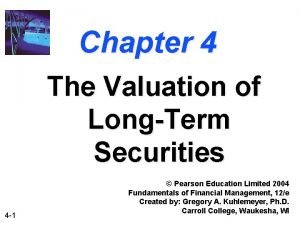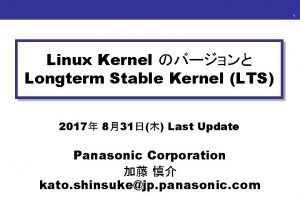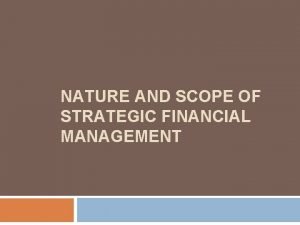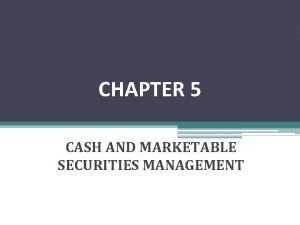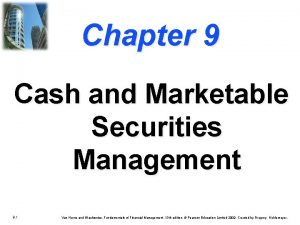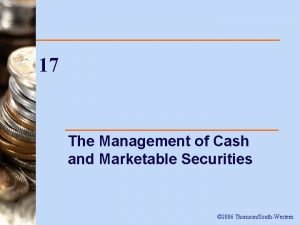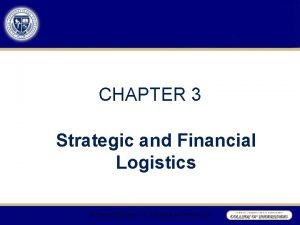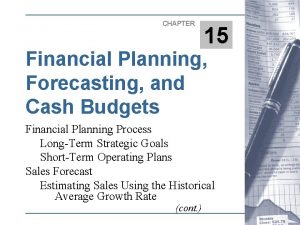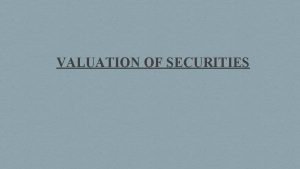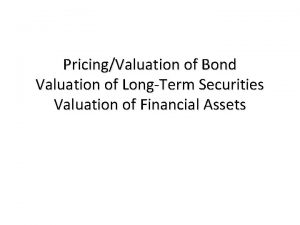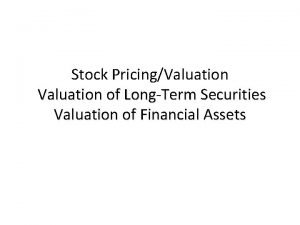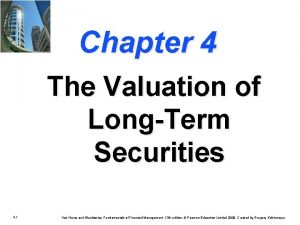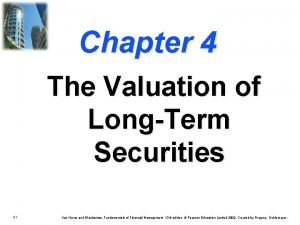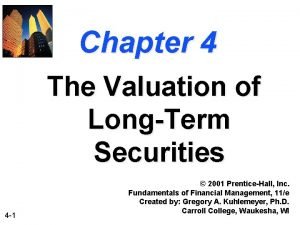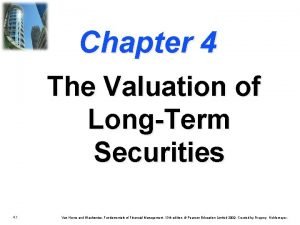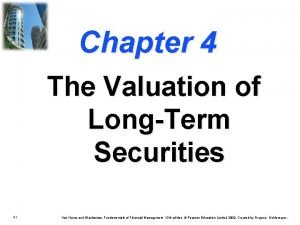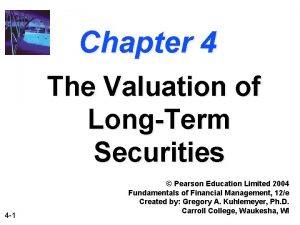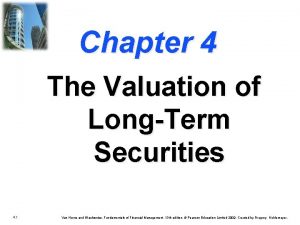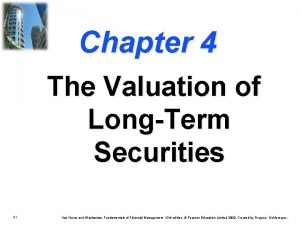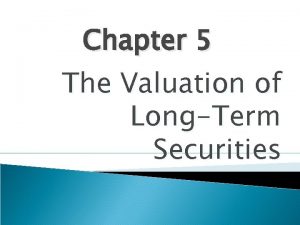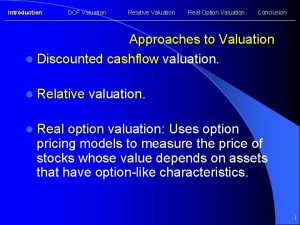Strategic Financial Management The Valuation of LongTerm Securities





















- Slides: 21

Strategic Financial Management The Valuation of Long-Term Securities Khuram Raza ACMA, MS Finance Scholar

Bond Valuation A bond is a long-term debt instrument issued by a corporation or government. q Face Value q Coupon Rate Perpetual Nonzero Zero Coupon Bonds Bounds Different Types of Bonds v Perpetual Bonds v Bonds with a Finite Maturity V=I/k • Nonzero Coupon Bonds. • Zero-Coupon Bonds d

Bond Valuation Semiannual Compounding Most bonds in the US pay interest twice a year (1/2 of the annual coupon). Adjustments needed: (1) Divide kd by 2 (2) Multiply n by 2 (3) Divide I by 2

Preferred Stock Valuation Preferred stock : A type of stock that promises a (usually) fixed dividend, but at the discretion of the board of directors. It has preference over common stock in the payment of dividends and claims on assets. V= Div. P (1 + k. P ¥ =S t=1 )1 Div. P + (1 + k Div. P (1 + k. P)t P )2 +. . . + or Div. P(PVIFA k. P, Div. P (1 + k. P)¥ ¥) This reduces to a perpetuity! perpetuity V = Div. P / k. P

Common Stock Valuation What cash flows will a shareholder receive when owning shares of common stock? stock (1) Future dividends (2) Future sale of the common stock shares

Dividend Valuation Model Basic dividend valuation model accounts for the PV of all future dividends. V= Div 1 (1 + ke)1 + ¥ Divt t=1 (1 + ke)t =S Div 2 (1 + ke)2 +. . . + Div¥ (1 + ke)¥ Divt: Cash Dividend at time t k e: Equity investor’s required return

Adjusted Dividend Valuation Model The basic dividend valuation model adjusted for the future stock sale. V= n: Div 1 (1 + ke)1 + Div 2 (1 + ke)2 +. . . + Divn + Pricen (1 + ke)n The year in which the firm’s shares are expected to be sold. Pricen: The expected share price in year n.

Dividend Growth Pattern Assumptions The dividend valuation model requires the forecast of all future dividends. The following dividend growth rate assumptions simplify the valuation process. Constant Growth No Growth Phases

Constant Growth Model The constant growth model assumes that dividends will grow forever at the rate g. D 0(1+g)2 D 0(1+g) V = (1 + k )1 + (1 + k )2 +. . . + (1 + k ) e D 1 = (ke - g) e e D 1 : Dividend paid at time 1. g: The constant growth rate. k e: Investor’s required return.

Constant Growth Model Stock CG has an expected dividend growth rate of 8%. Each share of stock just received an annual $3. 24 dividend. The appropriate discount rate is 15%. What is the value of the common stock? stock D 1 = $3. 24 ( 1 + 0. 08 ) = $3. 50 VCG = D 1 / ( ke - g ) = $3. 50 / (0. 15 - 0. 08 ) =$50

Zero Growth Model The zero growth model assumes that dividends will grow forever at the rate g = 0. VZG = = D 1 (1 + ke)1 D 1 ke + D 2 (1 + ke)2 +. . . + D (1 + ke) D 1 : Dividend paid at time 1. k e: Investor’s required return.

Growth Phases Model The growth phases model assumes that dividends for each share will grow at two or more different growth rates. n V =S t=1 D 0(1 + g 1)t (1 + ke )t + Dn(1 + g 2)t S t=n+1 (1 + ke)t

Growth Phases Model Note that the second phase of the growth phases model assumes that dividends will grow at a constant rate g 2. We can rewrite the formula as: n V =S t=1 D 0(1 + g 1)t (1 + ke )t + 1 Dn+1 (1 + ke)n (ke – g 2)

Growth Phases Model Example Stock GP has an expected growth rate of 16% for the first 3 years and 8% thereafter. Each share of stock just received an annual $3. 24 dividend per share. The appropriate discount rate is 15%. What is the value of the common stock under this scenario?

Growth Phases Model Example 0 1 2 3 4 5 6 D 1 D 2 D 3 D 4 D 5 D 6 Growth of 16% for 3 years Growth of 8% to infinity! Stock GP has two phases of growth. The first, 16%, starts at time t=0 for 3 years and is followed by 8% thereafter starting at time t=3. We should view the time line as two separate time lines in the valuation.

Growth Phases Model Example 0 1 2 3 3. 76 4. 36 5. 06 0 1 2 Actual Values 3 78 Where $78 = 5. 46 0. 15– 0. 08 Now we need to find the present value of the cash flows.

Growth Phases Model Example We determine the PV of cash flows. PV(D 1) = D 1(PVIF 15%, 1) = $3. 76 (0. 870) = $3. 27 PV(D 2) = D 2(PVIF 15%, 2) = $4. 36 (0. 756) = $3. 30 PV(D 3) = D 3(PVIF 15%, 3) = $5. 06 (0. 658) = $3. 33 P 3 = $5. 46 / (0. 15 - 0. 08) = $78 [CG Model] PV(P 3) = P 3(PVIF 15%, 3) = $78 (0. 658) = $51. 32

Calculating Rates of Return (or Yields) 1. Determine the expected cash flows 2. Replace the intrinsic value (V) with the market price (P 0). 3. Solve for the market required rate of return that equates the discounted cash flows to the market price

Calculating Rates of Return (or Yields) • a $1, 000 -par-value bond with the following characteristics: a current market price of $761, 12 years until maturity, and an 8 percent coupon rate (with interest paid annually). We want to determine the discount rate that sets the present value of the bond’s expected future cash-flow stream equal to the bond’s current market price.

Determining the Yield on Preferred Stock Determine the yield for preferred stock with an infinite life. P 0 = Div. P / k. P Solving for k. P such that k. P = Div. P / P 0

Determining the Yield on Common Stock Assume the constant growth model is appropriate. Determine the yield on the common stock. P 0 = D 1 / ( k e – g ) Solving for ke such that k e = ( D 1 / P 0 ) + g
 Fixed income securities
Fixed income securities Valuation of fixed income securities
Valuation of fixed income securities Valuation of long term securities
Valuation of long term securities Kernel longterm
Kernel longterm Thomas silverstein art
Thomas silverstein art Scope of registered valuer
Scope of registered valuer Industrial organization model of above average returns
Industrial organization model of above average returns Strategic analysis and choice in strategic management
Strategic analysis and choice in strategic management Scope of strategic financial management
Scope of strategic financial management Which one is marketable securities
Which one is marketable securities Cash and marketable securities management
Cash and marketable securities management Cash and securities management
Cash and securities management Cash and marketable securities management
Cash and marketable securities management Strategic fit vs strategic intent
Strategic fit vs strategic intent Strategic complements definition
Strategic complements definition Strategic and financial logistics
Strategic and financial logistics Chapter 15 financial forecasting for strategic growth
Chapter 15 financial forecasting for strategic growth Hát kết hợp bộ gõ cơ thể
Hát kết hợp bộ gõ cơ thể Frameset trong html5
Frameset trong html5 Bổ thể
Bổ thể Tỉ lệ cơ thể trẻ em
Tỉ lệ cơ thể trẻ em Chó sói
Chó sói


